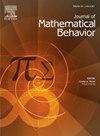作为联合认知行为的图表:数学证明中图表的对话说明
IF 1.7
Q3 EDUCATION & EDUCATIONAL RESEARCH
引用次数: 0
摘要
《演绎的对话根源》一书对演绎,特别是数学证明,进行了详细的对话描述。关键思想是,一个数学证明对应于两个(虚构的)参与者,证明者和怀疑论者之间的对话,其中证明者试图通过在怀疑论者中产生解释性说服来确定某些结论可以从某些前提中得出。虽然涵盖了数学证明的许多方面,但这本书没有讨论图表,尽管它们在数学实践中无处不在。在本文中,我弥补了这一重要的空白,在原来的对话叙述呈现。我认为图表在引出怀疑论者积极参与理解证明者提出的论点方面起着基本的认知作用。为此,证明者依靠命令来邀请怀疑者来构建图。因此,图表在数学证明中的作用主要是操作性的,而不是语义/表征性的,引发了“动手”的参与。特别是,我认为数学证明中的图表最好被理解为共同的认知行为,从而突出了它们在(数学)知识和理解的产生和传播中的作用。最后,我对图表对数学教育的影响进行了一些观察。本文章由计算机程序翻译,如有差异,请以英文原文为准。
Diagrams as joint epistemic actions: A dialogical account of diagrams in mathematical proofs
The book The Dialogical Roots of Deduction presented a detailed dialogical account of deduction, in particular of mathematical proof. The key idea is that a mathematical proof corresponds to a dialogue between two (fictive) participants, Prover and Skeptic, where Prover attempts to establish that some conclusion follows from certain premises by producing explanatory persuasion in Skeptic. While covering many aspects of mathematical proof, the book did not discuss diagrams, despite their ubiquity in mathematical practice. In this paper, I remedy this important lacuna in the original presentation of the dialogical account. I argue that diagrams play a fundamental epistemic role in eliciting active engagement from Skeptic to understand the argument put forward by Prover. To this end, Prover relies on imperatives to invite Skeptic to construct diagrams. Thus understood, the role of diagrams in mathematical proofs is primarily operative rather than semantic/representational, eliciting ‘hands-on’ engagement. In particular, I argue that diagrams in mathematical proofs are best understood as joint epistemic actions, thus highlighting their role in the production and transmission of (mathematical) knowledge and understanding. I close with some observations on the implications of this account of diagrams for mathematics education.
求助全文
通过发布文献求助,成功后即可免费获取论文全文。
去求助
来源期刊

Journal of Mathematical Behavior
EDUCATION & EDUCATIONAL RESEARCH-
CiteScore
2.70
自引率
17.60%
发文量
69
期刊介绍:
The Journal of Mathematical Behavior solicits original research on the learning and teaching of mathematics. We are interested especially in basic research, research that aims to clarify, in detail and depth, how mathematical ideas develop in learners. Over three decades, our experience confirms a founding premise of this journal: that mathematical thinking, hence mathematics learning as a social enterprise, is special. It is special because mathematics is special, both logically and psychologically. Logically, through the way that mathematical ideas and methods have been built, refined and organized for centuries across a range of cultures; and psychologically, through the variety of ways people today, in many walks of life, make sense of mathematics, develop it, make it their own.
 求助内容:
求助内容: 应助结果提醒方式:
应助结果提醒方式:


